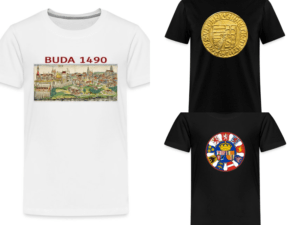Firearms in the Black Army

As we have seen, every fourth soldier in the Black Army had a gun. This rate was rare in Europe and also, it made the army very expensive.
The arquebusiers were gunpowder troops charged in the early stages of the battle. Their aiming ability, price and the danger of primitive hand-cannons (self-exploding) prevented them from being highly effective, especially against smaller groups of people or hand-to-hand combat. A distinctive Hungarian feature was that they did not use a fork to stabilize their guns but put it on top of the Pavese instead (or in some cases, on the parapet of a wagon in Hussite fashion).

Two types were simultaneously brought to practice, the schioppi (handgun) in the beginning, and later the arquebus à croc (not to be confused with cannons). In this picture, the Death is depicted on a fresco with an early schioppo gun:

Three classes of handguns were distinguished: the “bearded” light guns (hook-guns); forked guns; the first primitive muskets (iron tube compounded with wooden grip to be pushed against the shoulder). Their calibers varied from 16 to 24 mm. There were so many produced of them that they were used in a multitude even 60 years after the death of King Matthias. We can find them in many castles and the defenders took good use of them during the sieges.

Traditionally speaking, Hungarians had always been told to be good artillerymen and craftsmen, although the skills of the cannon-caster Master Orban is not to be proud of: he had designed the huge cannon for the Sultan to ruin the walls of Constantinapolis in 1453. We can find cannon-casting workshops in Pozsony (Bratislava, Pressburg) in 1440 where 24 lads worked under a master who was casting red copper cannonballs and bombs and grapeshot from 1442 on. They sent a huge cannon called „Csóka” to Governor Hunyadi János in 1454 whose copper weighed 1,171 pounds.

We know that King Matthias Corvinus had designed siege machines by himself at the siege of Szabács (Sabac) Castle in January 1476; he sent boats filled with men and cannons which were pulled up into the moat of the castle. He took the fort on 15 February.
When the king was besieging the strong fort of Haimburg in 1482 during his war against Emperor Frederick, we can find giant cannons in his army, one of them was a howitzer called „Varga”, it was dragged by 80 horses which were constantly changed. In the same year, he sent 17 great cannons from Buda to Pozsony.
The crossbow of King Matthias Corvinus

This crossbow is one of the earliest surviving dated examples to include heraldry in its decoration. It was made for Matthias Corvinus (1443–1490), king of Hungary and Bohemia, whose personal coat of arms and the arms of his kingdom are visible. In addition to its rich ornament, the crossbow is remarkable for its sophisticated firing mechanism.

Title: Crossbow of Matthias Corvinus, King of Hungary (reigned 1458–1490)
Date: dated 1489
Geography: possibly Vienna
Culture: Central or Eastern European, possibly Vienna
Medium: Wood, horn, animal sinew, staghorn, birch bark, iron alloy
Dimensions: L. 29 in. (73.7 cm); W. 24 in. (60.9 cm); Wt. 5 lb. 1/2 oz. (2284 g)

More pictures:



Source: partly from Hagyomány és Múltidéző
You can read more about King Matthias Corvinus on my page:
https://www.hungarianottomanwars.com/essays/king-matthias-corvinus-1443-1490/
Dear Readers, I can only make this content available through small donations or by selling my books or T-shirts.
If you like my writings, please feel free to support me with a coffee here:
You can check out my books on Amazon or Draft2Digital, they are available in hardcover, paperback, or ebook:
https://www.amazon.com/dp/198020490X
or at https://books2read.com/b/boYd81



My work can also be followed and supported on Patreon: Become a Patron!http://Become a Patron!

